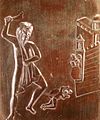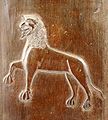Bronze door of the Augsburg Cathedral
The old bronze door of Augsburg Cathedral is one of 12 important Romanesque bronze portals in Europe and is one of the best examples of medieval foundry art north of the Alps .
The old bronze portal
In order to protect the portal from further destruction by air pollutants , it was expanded in 2002 and moved to the St. Afra diocesan museum in Augsburg . The restoration was completed at the end of 2004 . The unequal sized door leaves are decorated with 35 cast bronze reliefs and together with the Bernward door from 1015 in Hildesheim Cathedral one of the oldest bronze portals with figurative representations. The Augsburg bronze portal was probably created for the Ottonian cathedral, which was newly built between 995 and 1006 . The original location was perhaps the east side, as there was a large forecourt here.
The Augsburg bronze portal has similarities with Italian and Byzantine bronze doors . The client had detailed ideas of similar Byzantine doors. The meaning of the content is difficult to interpret due to the missing parts. The meaning is most readily apparent against the background of Christian symbolism: the church door as the boundary between the earthly world and heavenly paradise , which only allows the righteous to enter and rejects the unworthy, but through which Christ himself leads the believers and repentant sinners to eternal life - besieged of evil forces unsuccessfully trying to overcome this limit and serving as a warning to the believers. The typological-salvation-historical program of the antique-looking plates depicts the struggle between sin and redemption . The individual representations come from three thematic areas: Genesis with the creation of man and the fall of man , other books of the Old Testament with persons considered to be the forerunners of Christ ( Moses , Aaron , Samson , David ) and finally medieval animal symbolism ( lion , bear , centaur , birds , chickens ). Representations of the months and seasons as well as constellations are also used for interpretation.
The new bronze portal
The south side of the cathedral received a new portal door in 2000 ( Holy Year ) instead of the Romanesque bronze door from the 11th century. The Munich sculptor Max Faller created a cathedral door with 28 bronze reliefs of the Biblical Annunciation on behalf of the cathedral chapter . The theme is God's creation, which is completed through the life-giving effect of the Holy Spirit ( Jn 10.9 EU ). From the prophecies of the Old Testament and its most striking figures such as the progenitor Abraham and Moses to the fulfillment of all prophecy in Christ's crucifixion and resurrection , this work created a picture Bible in the tradition of the classic bibla pauperum ( poor Bible).
Detailed views of the old portal
Lion head as a ring of grace and door puller
literature
- Dorothea Diemer, Peter Diemer: The bronze door of the Augsburg cathedral . In: Journal of the German Association for Art Science 65, 2011 (published 2013), pp. 9–92.
- Droste, Thorsten : The bronze door of the Augsburg cathedral. Art history and technology. In: Yearbook of the Association for the History of the Augsburg Diocese, Vol. 14 (1980) pp. 7–76 and The bronze door of the Augsburger Domes. Their history and position under the bronze doors of the Middle Ages. In: Yearbook of the Association for the History of the Augsburg Diocese, Vol. 15 (1981) pp. 169–213
- Bösl, Hanna u. Bartl Franz: The Augsburg cathedral door. , Freilassing: Pannonia-Verlag, 1985, ISBN 3-7897-0126-2
- Chevalley, Denis André: The cathedral in Augsburg , Munich: Verlag Oldenbourg, 1995; ISBN 3-486-55960-5
- Schnell, Werner: The Cathedral of Augsburg , Passau: Art Publishing House Peda 2005, ISBN 3-929246-26-0
- Diemer, Dorothea: The bronze door of the Augsburg cathedral. In: Kaufhold, Martin (ed.): The Augsburg Cathedral in the Middle Ages, Augsburg: Wißner-Verlag 2006, ISBN 978-3-89639-518-4
Web links
References and comments
- ↑ So the new dating suggestion by Diemer and Diemer 2013, which builds on the building history of the cathedral 996-1006, which has been specified by current building research. So far the portal has been dated to the middle of the 11th century.
- ↑ Diemer and Diemer 2013.
Coordinates: 48 ° 22 ′ 21 ″ N , 10 ° 53 ′ 46.9 ″ E























